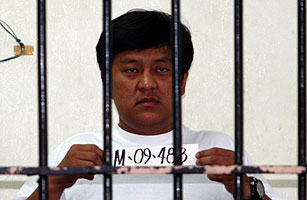
One year ago on Tuesday, at least 57 men and women, including 31 journalists, were slaughtered on a grassy clearing in the southern Philippines. They were on their way to a political event, driving caravan-style through Maguindanao province’s rugged, green hills when their convoy was stopped by armed men — allegedly members of a private army controlled by Andal Ampatuan Jr., the scion of the clan that rules the area. They were forced out of their vehicles, lined up and executed. The killers used a state-owned backhoe to dig shallow mass graves and began to dump the bodies, stopping only when it ran out of gas. Later that day, investigators used the same claw to probe the muddy pits.
On Tuesday, at a vigil to mark the anniversary of the killings, a backhoe will be burned in effigy. In a country all too accustomed to violence, the machine has become an improbably grim symbol of the cruel impunity with which the Philippines’ warlords operate — and the government’s routinely inept response.
The Maguindanao massacre, as it’s now known, was the single worst attack on journalists ever recorded. One year on, however, several independent investigations suggest that the violence matched a broader pattern of abuse. A report released last week by Human Rights Watch links the Ampatuan clan to decades of violence in the province, including torture, abduction and the murder of eyewitnesses. They claim that there are at least 100 other private armies in the Philippines, often functioning above or in collusion with the state. Given the lawlessness and impunity that reigns in the country’s south, the incident was, according to the report, “an atrocity waiting to happen.” Many worry it could happen again.
Journalists in the Philippines are particularly fearful — and with good reason. Their country has long been one of the most dangerous places in the world for media personnel. Since the mid-1980s, more than 100 journalists have been killed in the line of duty. The crimes usually go unpunished; killers have walked free in 90% of the country’s media murders since 1992, according to the Committee to Protect Journalists. In late August, the CPJ sent a fact-finding team to the scene of the Maguindanao massacre. They were given a military escort that included several large vehicles and heavily armed troops. It was clear that parts of the province, including that infamous hilltop, remain under the control of the Ampatuan family, says Shawn Crispin, a member of the fact-finding team, who adds that the risk of attack is still “very, very high.”
The government’s investigation of the murders, meanwhile, has been hobbled by incompetence, neglect and, according to some, complicity. The CPJ investigation found that first responders used the backhoe unnecessarily, disturbing the bodies and contaminating evidence. The Human Rights Watch report notes that some officials did not wear gloves at the scene, and to this day, nobody can explain why 22 corpses were moved from their original positions before the forensic team arrived. Even the number of victims is up for debate: the dentures and identity papers of a 61-year-old photojournalist were found at the scene, but his body was never recovered. Nobody is certain if the ham-handed investigation was the product of rash incompetence or a deliberate attempt to hide the truth. But, says the CPJ’s Crispin, messing with evidence is alarmingly common in such cases.
Meanwhile, the government’s case against Andal Ampatuan is proceeding slowly. Though he is on trial for murder , 126 other suspects in the case are still at large, which means witnesses are at risk. One key witness, Suwaid Uphan, was killed in June after he admitted on television to being part of the seven-man death squad that carried out the killings and named other suspects. Court delays, a regular feature of the Philippines’ slow-moving justice system, are also a problem, says Malou Mangahas, a journalist and board member at the Southeast Asian Press Alliance. The family members of the victims are struggling to stay afloat financially, and there are unconfirmed reports that people claiming to be members of the Ampatuan clan have offered them cash to drop the charges. If the proceedings stretch on, it may be tough to maintain momentum, particularly if some families back out.
The handling of the investigation has become a bellwether of sorts, a test of the country’s cumbersome courts and a measure of the new government’s commitment to reform. President Benigno Aquino, elected in June, has promised to hold the killers accountable and to dismantle the network of powerful clans and private armies that flourished under the previous administration. On Tuesday he asked government employees to wear black, a symbol, he said, of the nation’s grief. He has also asked the country’s Supreme Court to allow video coverage of the case in order to increase transparency. Marites Vitug, a journalist and author, says Aquino is taking the right steps but faces a daunting task. “How can the President disentangle a political culture of impunity?” she asks. “This is a government of good intentions, but they must follow through.” Indeed; in Maguindanao, there is every indication that good intentions won’t be enough.
— With reporting by Hans Villarica
See TIME’s Pictures of the Week.